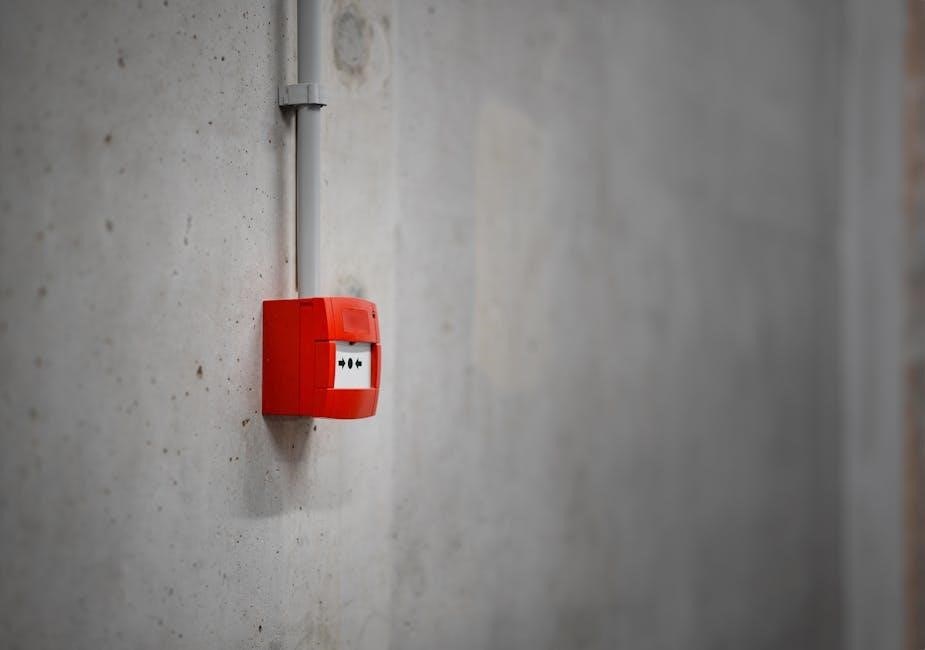A rolling offset is a pipe configuration that changes direction in both horizontal and vertical planes, requiring precise calculations for accurate installation․ It ensures flexibility and efficiency in plumbing systems․
What is a Rolling Offset?
A rolling offset, also known as a compound or diagonal offset, is a pipe configuration that changes direction in both the horizontal and vertical planes simultaneously․ Unlike a simple offset, which only alters direction in one plane, a rolling offset requires more complex calculations to determine the correct measurements․ This configuration is essential in plumbing, HVAC, and industrial piping systems where pipes need to navigate around obstacles in three-dimensional space․ The rolling offset involves the use of fittings, such as 45-degree elbows, to create gradual direction changes․ It ensures proper flow characteristics while providing flexibility in pipe routing․ The true offset, calculated using the Pythagorean theorem, combines horizontal and vertical distances to determine the center-to-center distance, which is critical for accurate installation․ This method is widely used to maintain efficiency and precision in modern piping systems․
Importance of Rolling Offset in Pipe Fittings
The rolling offset plays a crucial role in pipe fittings by enabling pipes to navigate around obstacles in three-dimensional space․ It ensures that pipes can change direction both horizontally and vertically, maintaining proper flow characteristics and system efficiency․ This configuration is essential in plumbing, HVAC, and industrial piping systems where space is limited and flexibility is required․ By accurately calculating the rolling offset, installers can avoid costly mistakes and ensure that pipes are correctly routed, reducing the risk of leaks and maintaining system performance․ The use of rolling offsets also minimizes the need for multiple fittings, simplifying the installation process and reducing material costs․ As a result, it is a fundamental technique in modern piping systems, ensuring both functionality and cost-effectiveness․

Key Concepts and Formulas
The rolling offset formula involves calculating horizontal and vertical distances, center-to-center distance using the Pythagorean theorem, and determining the angle using trigonometric functions for precise pipe fitting measurements․
Horizontal and Vertical Distances in Rolling Offset
In a rolling offset, horizontal and vertical distances are measured between pipe centers․ The horizontal distance is the straight-line measurement in the plane, while the vertical distance is the straight-line measurement in the vertical plane․ These two measurements are crucial for calculating the true offset, which is the hypotenuse of the right triangle formed by the horizontal and vertical distances․ Using the Pythagorean theorem, the true offset (C) is calculated as C = √(H² + V²), where H is the horizontal distance and V is the vertical distance․ This calculation forms the basis for determining other parameters like the travel distance and cut length of the pipe․ Accurate measurements of these distances are essential for ensuring proper pipe alignment and installation, especially in complex piping systems where multiple offsets are required․
Center-to-Center Distance Calculation
The center-to-center distance in a rolling offset is the diagonal distance between the centers of the two pipes․ It is calculated using the Pythagorean theorem, combining the horizontal and vertical distances․ The formula is:
C = √(H² + V²), where H is the horizontal distance and V is the vertical distance․ This calculation provides the true offset, which is the hypotenuse of the right triangle formed by the horizontal and vertical measurements․ The center-to-center distance is critical for determining the travel distance and cut length of the pipe․ By accurately measuring the horizontal and vertical offsets, the true offset can be derived, ensuring precise pipe alignment․ This calculation is essential for proper installation, especially in complex systems with multiple offsets․ It forms the foundation for further calculations, such as travel distance and cut length, ensuring the pipe fits correctly in three-dimensional space․
Angle Calculation in Rolling Offset
The angle calculation in a rolling offset determines the direction change relative to the horizontal plane․ It is calculated using the arctangent function:
Angle = tan⁻¹(V/H), where V is the vertical distance and H is the horizontal distance․ This angle is crucial for determining the orientation of the pipe and the type of fittings required․ The angle ensures that the pipe transitions smoothly from one position to another, maintaining proper flow characteristics․ For 45-degree fittings, the angle calculation simplifies, making it a common choice in many installations․ The calculated angle also helps in selecting the appropriate elbows or bends, ensuring the system’s efficiency and compliance with design standards․ Accurate angle calculation is vital for avoiding installation errors and ensuring the system’s performance meets specifications․
Travel Distance and Cut Length Formulas
To determine the travel distance and cut length for a rolling offset, specific formulas are applied․ The travel distance is calculated by subtracting the fitting allowances from the center-to-center distance․ The formula is:
Travel Distance = Center-to-Center Distance ⏤ Fitting Allowance․
The cut length equals the travel distance, ensuring the pipe fits correctly with the fittings․ For 45-degree fittings, the calculations simplify, but other angles require adjustments․ These formulas ensure accurate measurements for efficient pipe installation․

Practical Applications and Tips
Practical applications involve using online calculators for precise measurements and selecting the right fittings․ Tips include creating mock-ups and double-checking measurements before cutting pipes for efficient installation․
Measuring for Rolling Offset in the Field
Measuring for a rolling offset in the field involves several key steps to ensure accuracy․ First, identify the start and end points of the pipe run using a level and tape measure to determine the horizontal distance․ Next, measure the vertical distance using a plumb bob or level to account for any elevation changes․ Note the pipe diameter, as it affects fitting allowances․ Use a rolling offset calculator or formula to determine the center-to-center distance, angle, and cut length․ Mark these measurements on the pipe, considering fitting insertion depths if socket-type fittings are used․ Double-check all measurements before cutting to avoid errors․ For complex installations, create a mock-up using inexpensive materials or mark measurements on the floor or wall to visualize the offset․ This ensures precise alignment and minimizes costly mistakes during installation․
Choosing the Right Fittings for Rolling Offset
Selecting appropriate fittings is crucial for a successful rolling offset installation․ Commonly, 45-degree elbows are used due to their balance of flow characteristics and space efficiency․ However, other angles like 22․5 or 60 degrees may be required for specific applications․ Weld elbows are ideal for high-pressure or high-temperature systems, offering durability and leak-proof connections․ Compression or push-fit fittings are suitable for easier installation without special tools, making them convenient for residential plumbing․ Consider factors such as pipe material, pressure requirements, temperature, accessibility, and local plumbing codes when choosing fittings․ Proper fitting selection ensures smooth flow, reduces potential leaks, and meets system performance standards․ Always consult with a professional for critical or high-pressure applications to ensure compliance and reliability․ This careful selection guarantees a robust and efficient piping system tailored to the project’s needs․ Proper fitting selection is essential for long-term performance and safety․
Practical Tips for Pipe Installation
For successful rolling offset installations, start by accurately measuring horizontal and vertical distances between pipe centers using a level and tape measure․ Use a rolling offset calculator to determine center-to-center distance, angle, and cut length․ Always mark measurements on the pipe, accounting for fitting insertion depths if using socket-type fittings․ Double-check all measurements before cutting to avoid costly mistakes․ Consider creating a mock-up with inexpensive materials to visualize the offset․ For complex installations, consult a professional plumber or pipefitter, especially for critical systems․ Ensure compliance with local plumbing codes and material specifications․ Proper planning and precise execution ensure efficient and reliable pipe routing․ These practical tips help achieve accurate and durable pipe installations, minimizing errors and optimizing system performance; Careful preparation and execution are key to successful rolling offset projects․

Rolling Offset Calculator and Tools
A rolling offset calculator simplifies pipe installation by calculating travel distance, cut length, and angles․ Key features include support for various fitting angles and unit conversions for precise measurements․
Using Online Rolling Offset Calculators
Online rolling offset calculators are essential tools for streamlining pipe installation calculations․ These calculators allow users to input horizontal and vertical distances, fitting angles, and pipe diameters to determine precise measurements․ By entering the required offsets, the calculator computes the center-to-center distance, travel distance, and cut length, ensuring accurate results․ Many calculators support multiple fitting angles, such as 45 degrees, and provide results in various units for convenience․ They also offer features like feasibility checks and practical tips for installation․ Using these tools saves time and reduces errors, making them indispensable for professionals in plumbing, HVAC, and industrial piping․ Double-checking measurements before cutting pipe is always recommended to ensure a flawless installation․
Key Features of Rolling Offset Calculators
Rolling offset calculators are designed to simplify complex pipe fitting calculations․ They offer features like multi-unit support, allowing users to input and receive measurements in inches or centimeters․ These tools can handle various fitting angles, such as 45 degrees, and provide detailed formulas for travel distance and cut length․ Some calculators include visual aids, like diagrams, to help users understand the pipe configuration better․ They also offer practical tips for installation, such as marking measurements on pipes before cutting․ Advanced versions may include error-checking features to ensure accurate results․ Overall, these calculators are invaluable for professionals needing precise measurements in plumbing, HVAC, and industrial piping systems, ensuring efficient and error-free installations․

Common Mistakes and Solutions
Common mistakes include incorrect measurements and miscalculations of angles․ Solutions involve double-checking measurements, using correct formulas, and consulting professionals for complex installations to ensure accuracy and safety․
Addressing Common Queries and Misconceptions
A common query is whether rolling offsets are suitable for all pipe materials․ While they are versatile, material-specific fittings may be required․ Misconceptions include believing that rolling offsets only apply to 45-degree angles, but they can accommodate various angles․ Another myth is that rolling offsets are overly complex, when in fact, using calculators simplifies the process․ Proper understanding and tools can address these misconceptions, ensuring accurate and efficient pipe installations across different systems․
Troubleshooting Rolling Offset Measurements
Common issues in rolling offset measurements include incorrect calculations of horizontal and vertical distances, leading to improper fitting selection․ Ensure accurate measurements using a level and tape measure․ Misalignment often occurs due to miscalculating the center-to-center distance, which should be derived using the Pythagorean theorem․ Additionally, neglecting the fitting allowance can result in incorrect travel and cut lengths․ Double-checking measurements and using a rolling offset calculator can mitigate these errors․ For complex installations, creating a mock-up or marking measurements on-site before cutting pipe is recommended․ Always verify fitting compatibility with the pipe material and angle requirements to avoid installation issues․ Proper planning and precision are key to resolving common challenges in rolling offset measurements․
